Review: Stray (2022)
Come for the Cat, Stay for One of the Best Indie Games Ever Made
Initially, Stray had a lot going for it. People of all ages and cultures love cats, and playing as one in a game is novel and cute. It’s developed by an indie studio and published by Annapurna, a studio well-liked for their critically acclaimed indie darlings like Outer Wilds and What Remains of Edith Finch. The final selling point, at least for me, is the attractive cyberpunk aesthetic, ideal for showcasing current-gen dynamic lighting and ray tracing tech and as a perfect playground for a cat to adventure in. Stray really does advertise and sell itself. The only question I had was if Stray would execute on its ripe premise well and follow through on all of its potential. Well, it easily achieves the promise of its initial premise and goes above that and firmly into the art category. Any thoughts I had that this would just be another gimmicky, humorous game like Untitled Goose Game or a jokey meme game such as Goat Simulator were put to rest almost as soon as I started exploring the initial area.
You begin the game in the most simple scenario imaginable: you’re one of three cats living in an uninhabited ditch and must explore for food and/or shelter. Controlling the cat is a simple and intuitive affair if you’ve played any 3rd-person game. It’s so intuitive that, before I knew it, I was playing and exchanging paws with my fellow stray cats in an alcove whilst meowing and purring to my heart’s content. Yes, Stray has a dedicated meow button. There’s no on-screen HUD or objective markers cluttering the screen, which serves to highlight just how gorgeous the visuals and colorful hues of the environments are.
Graphics
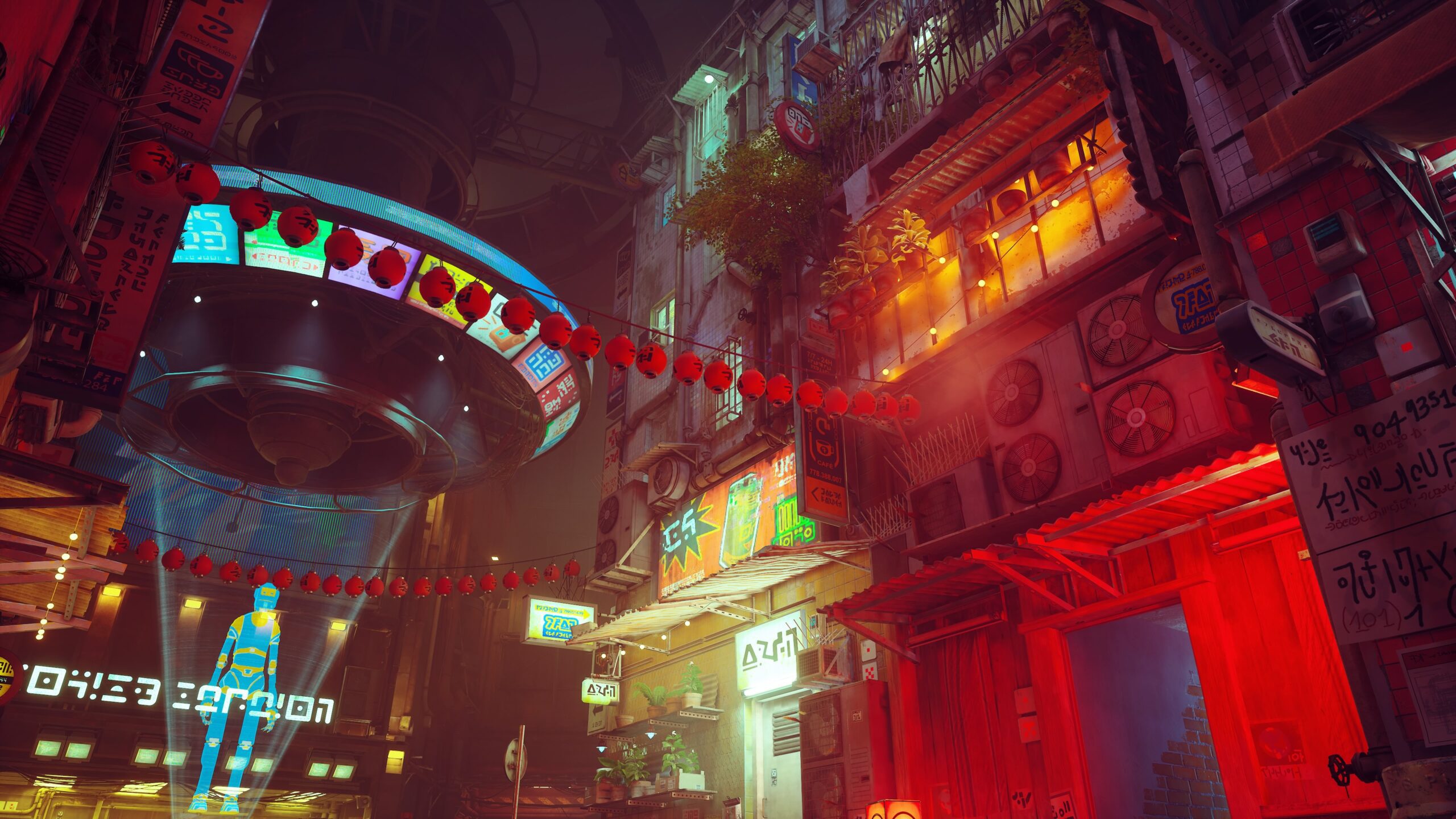
It’s perhaps here in the visuals when I put away any doubts that this game wouldn’t live up to its trailers. Stray looks even more spectacular when playing it live. We already knew Stray looked good from trailers and whatnot, but I didn’t know it all looked this good. I thought, “Surely, they’re hiding something in these trailers,” but nope, it really is all exquisitely detailed without reserve. The first time I panned the camera around our cat hero, I think I might have audibly gasped. The sheer amount of attention to detail in the environment and the effort to make it as believable and organic as possible really becomes apparent when you look around at the nooks and crannies. The textures of these sights are no less impressive, with little markings of wear and age uniquely covering all the architecture and various relics of the beautifully dystopian landscape.

Though, it must be noted that some of the items, when zoomed in on, do have blurry texture quality. Thankfully, these objects are very few and far between, and even if some textures are a little rougher to look at, Stray’s dynamic lighting helps make it look attractive regardless. The color palette is good as is, but the neon lights that illuminate the dark, seedy streets of the cybercity are mesmerizing. My PS5 was put to good use with plenty of ray tracing and dynamic HD lighting being displayed through the environs. In particular, the neon-lit shades of green and blue with their reflections being beamed off dusty walls and trash-filled streets is something I never tired of marveling at. And, yes, even the trash looks good in its detail and lighting, unlike some of the trash littered across the, admittedly, far larger Night City in Cyberpunk 2077. Style and fidelity join together in full bloom in illuminating the dark dystopian city for our stray cat to explore. Neon really does make the city pop. There were only one or two instances where the chromatic aberration from a light source against a dark wall created a bizarre, if not ugly, effect of light distortion. I went and fiddled with the motion blur and brightness in the visual options but couldn’t get rid of the refraction effect of these couple of light sources, but other than one or two instances, the lighting in Stray is nothing short of incredible.
Artistic Design
It’s not just Stray’s graphical fidelity that so impressed me, but the artistic design of the environments and the amount of unique detail that went into it all. Every single environment in Stray looks authentically organic and lived-in, and I mean that quite literally. I can’t think of a single area in the game that doesn’t have a unique and hand-crafted design. As I was making my way exploring the large ditch in the intro, I passed intricate pipe systems, sewage access vents, various species of flora and fauna, and a number of pits outlined by concrete looking over giant, moss-covered walls and precarious precipices, and none of it looked like a copy/paste job from the comfort of a computer. The organic layout of the environments shares a similar style of level design intricacy as a game like Half-Life 2 with its unconventional routing through vents and derelict bridges and labyrinthine tunnel systems. This design emphasizing the rough edges and imperfections of a lived-in world in need of repair suit Stray’s world perfectly and caters to the strengths of a cat as an explorer. In fact, much of the atmosphere and sound design are similar in their effect to the buzzing street lamps and far-off drones found in the lonely yet richly immersive locations of Half-Life 2 as well. In case you think I’m reaching with the Half-Life comparisons, take a closer look at the chapter select screen.
Cybercity Music
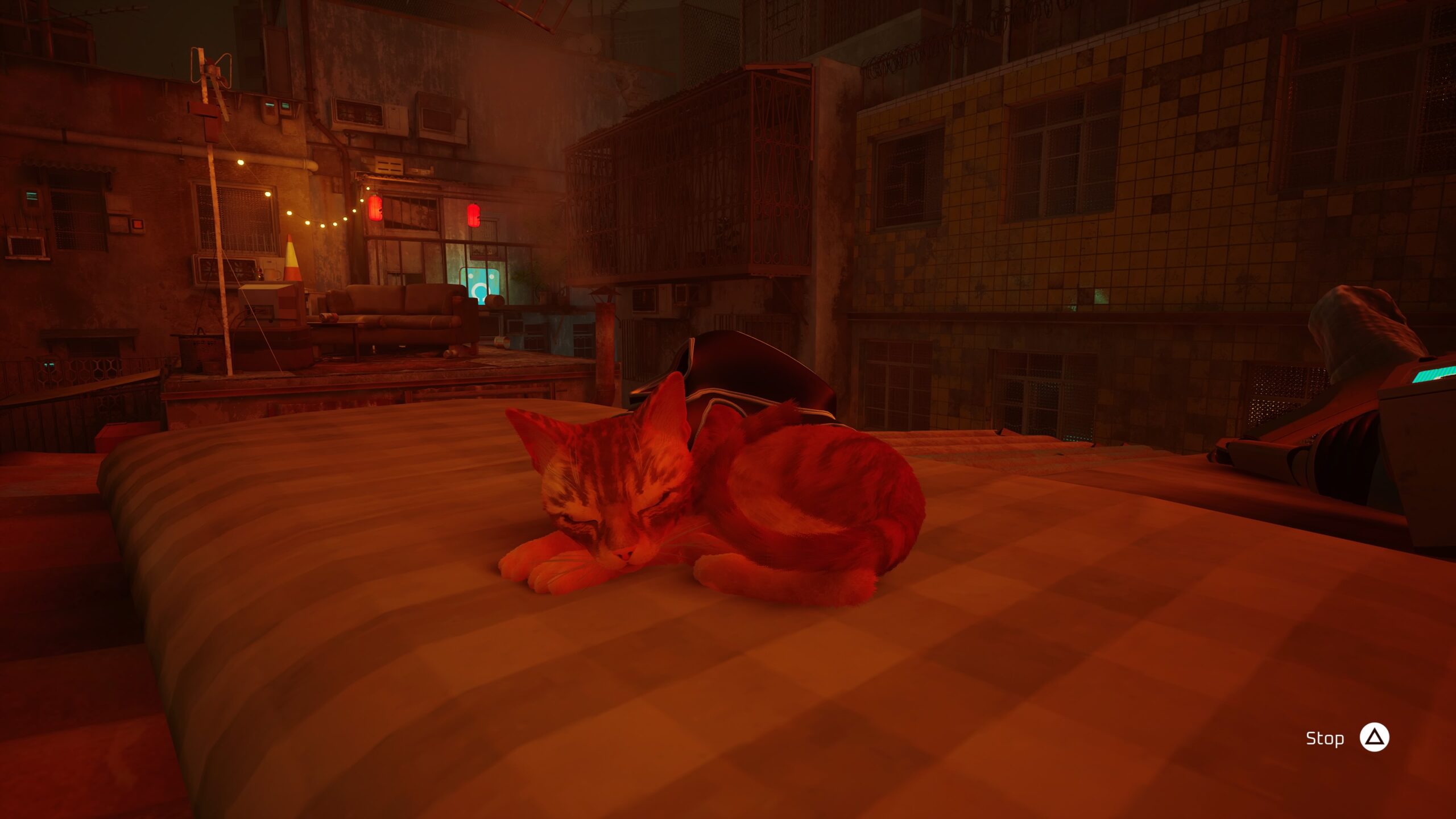
The Half-Life comparisons don’t stop there, though. The music is similarly implemented to accent the atmosphere, except Stray does it a tad better. During periods of slow exploration, you’ll be accompanied by the atmospheric whirrings of the cityscape without music. The times the music does play are that much more notable and punctuated because of the contrasting silence. The frequency in music is far more active than something like Half-Life or Dark Souls. Certain key moments cue a particular music track, and each zone has its own themes which play on and off at an almost perfect interval. The quality of the music is absolutely stellar. One thing I adore about Stray’s soundtrack is how subtle and efficient it is while still being emotional, exciting, and contextual. As someone who’s tried their hand at music composition for a decade, I can say that one of the most difficult objectives in the craft is being honest and lean with what you are expressing musically. Stray’s music, and the game as a whole for that matter, hit the perfect balance of telling a distinct story about a setting with emotion and conviction while remaining honest and saying just what it needs to without becoming overbearing. I love the very subtle yet clear cat-meow motifs strewn through the music in particular. Much of the soundtrack focuses on rhythm and harmony to create a rich ambiance. When a strong, singable melody hits, it’s all the more poignant and stirring due to the otherwise minimalistic presence of melody. I love the glitch-pop elements imitating the mechanical/artificial features of the setting and how a strong rhythmic beat accompanies much of the whirrings of the techno-inspired soundtrack. The soundscape is an ambient treat for the ears, with a rich serving of luscious harmonies and driving rhythms, often utilizing jazz chords to match the noir feeling of the cybercity. There’s even a profound piano piece that plays on the main menu if you wait long enough. This piece might be my favorite track in the game, reminding me of contemporary composers like Ryuichi Sakamoto and Masashi Hamauzu with their impressionist piano music. Though, a game can sound as lovely and look as amazing as the best works of art and still fail at being playable without a good control scheme to enjoy the sights and sounds with. Thankfully, it’s simple and smooth to navigate with our feline hero.
Controlling the Cat

Stray’s control scheme is charmingly simple, with a smart emphasis on context commands. It might be disappointing to hear that Stray features no dedicated jump button, but I found this to be for the game’s benefit since giving me the option to jump anywhere and everywhere is a recipe for glitches and platform deaths. Stray is a relaxingly glitch-free game, and I’d assume part of that is because they didn’t get too wild with the controls and kept it simple and succinct. Most ledges and obstacles can be jumped on when approached, and I found the context-specific commands to be smooth and responsive with little to no delay or fuss. Likewise, the movement radius of the cat is pretty sharp and responsive, though not quite the most precise I’ve felt in a game. Still, the movement never hampered what I wanted to do and where I wanted to go. Even the action-oriented segments controlled smooth enough to not notice a lack of frame-perfect precision. Thankfully, precision isn’t needed in contextual actions such as jumping. If you’ve played any of the decent Assassin’s Creed games, you’ll find the platforming to be comfortable and intuitive. While not every ledge and obstacle is interactable and climbable, the majority of the unclimbable balconies or rooftops don’t impede progress or irritate the smooth gameplay. I never felt like I was smacking into invisible walls or walking into out-of-bounds zones only to be jarringly warped back. If a place is unreachable and cannot be traversed, no contextual cue will show up on-screen; it’s as simple as that. No flailing around trying to stay on an invisible ledge only to get stuck inside the broken terrain; Stray just outright denies you the action from the start. Both open-world and linear games struggle to remain glitch-free regarding interactable terrain, so I find the contextual jumping to be a good compromise. In general, Stray does such an excellent job at not killing you due to clumsy game design. The cat locks on to the obstacles like glue and has a general resistance to falling off ledges and cliffs, which I suppose is a testament to cats having nine lives. The player is very rarely fighting the controls or struggling to force the cat to do an action it doesn’t want to do. Either you can go there and do that, or you can’t, and that simplicity is to Stray’s ultimate benefit.
Exploring the Cybercity
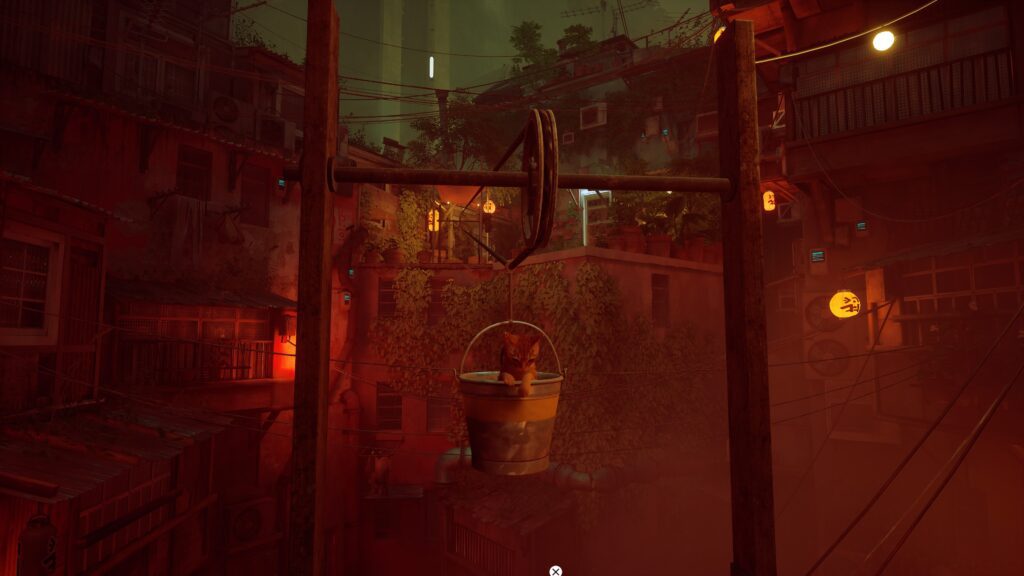
But what good would smooth controls and maneuverability do without the environment in which to use them? Like most things in Stray, the way you transition between levels is an organic process that feels entirely natural as you explore the cybercity. The design of the city itself is masterfully realized in how dense and dynamic it is. While Stray isn’t exactly an open-world game, it isn’t entirely linear either. The game pays respect to the curious, nomadic nature of cats and gives you plenty of room to explore its compact neon streets without it ever being overwhelming. There’s just the right amount of nooks, crannies, and precarious ledges for a cat to adventure in, and again, none of it feels repetitive. Every street feels unique, every building has a different layout of ledges and window panes, and everything looks fresh and organically designed. At a key moment, you’ll have access to a help command that gives you hints on what to do and where to go next. The method by which you receive these hints doesn’t consist of markers littered on a map or an objective log but through the insight of an AI companion you meet after the opening stretch of the game. Your companion never knocks you over the head with specific descriptions of where to go next, and I found all the hints to be just helpful enough without spoiling the fun of figuring it out yourself. Though, to the game’s benefit, I hardly ever needed hints from my AI companion in the first place because of the clear and easy-to-understand layouts of the environments and current objectives. There are just not a whole lot of noticeable video-gamey cliches in Stray, especially when it comes to its level design and progression. Much of your progress is initially achieved through exploration and curiosity, two things cats specialize in. This emphasis on exploration shines the most when scouring the hub-like zone of the Slums. This is one of the more open areas you’ll encounter, and you’ll find yourself climbing on plenty of high ledges, crawling through small cubby holes, and even zip-lining across the little town in your efforts to unravel the mystery of the cybercity. You’ll uncover much of the city’s background lore and develop your relationship with the denizens here in the large Slum area, so it’s good that exploration is enticing and fun to facilitate that. The compact level design of hub areas like the Slums is one of Stray’s crowning achievements. Whether it’s finding various pages of sheet music for the local musician bot to play tunes, opening up and discovering new locations through crawlspaces and little puzzles, or meeting the various robot residents and learning about the cybercity and its mysteries, everything you do is interesting and fun. Stray gives you the room, time, and resources to be a cat in a big city through the more open hub areas.
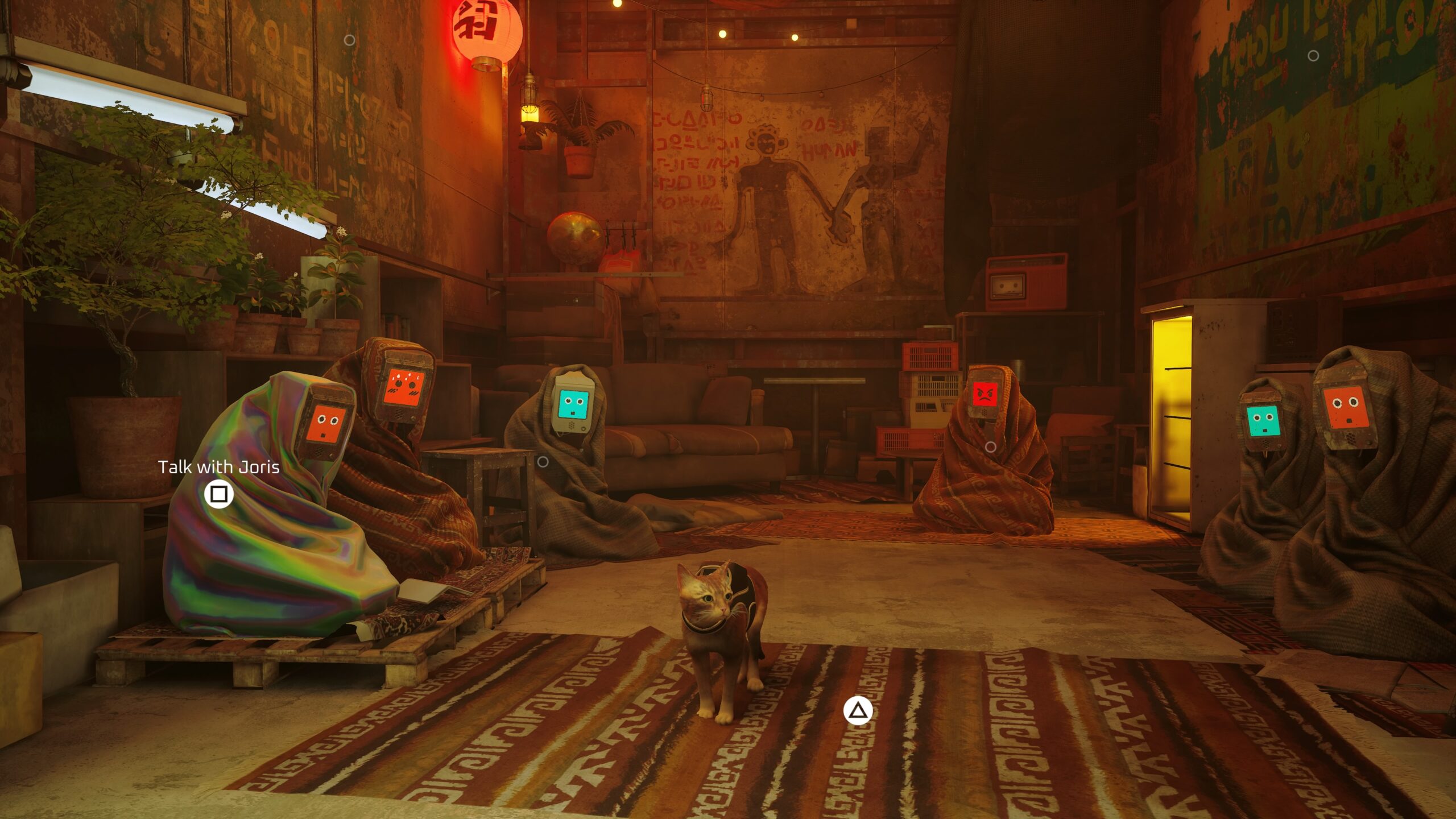
One of the more interesting aspects of this larger hub-like area is the adventure-game style trade aspect. Stray is so mesmerizing and interesting that you’ll almost never notice that it uses traditional adventure game puzzles to open up progression in the more explorative sections. You’ll often find yourself freely exploring the neon-lit rooftops, finding various objects like keys, trinkets, and sheets, all of which act to either flesh out the lore and setting or to be used for trading with the quirky citizens scraping out an existence for themselves. I’m not the biggest fan of adventure game logic requiring finding hidden objects and knowing where to use them and in what combination or order, so it was such a relief when I found out these find-and-trade sections were optional for the most part and natural to come across at your own pace in the instances where they were mandatory. I found most of the items scattered through the town that I needed to progress before even reaching the part in the story requiring them. Stray’s world is just that attractive and enjoyable to explore. If, however, you didn’t explore and need to collect stuff specifically to advance, the citizens and your own companion bot give you hints and comment on where they might have seen what you’re looking for. The collectible memories in every level are another fun diversion that adds up to this subtle collectathon element, and memories also give characterization to your companion AI bot named B12. You find out interesting details of what day-to-day life used to be like in the city and insight into certain key events leading to when the city devolved into a dark, seedy neon dystopia. These scattered memories are fun to look for and often rewarding in their characterization and setting insight but are not necessary to advance the game in any way. The contrast and pacing between the more open, explorative leisure moments in the hub and the brisk, action-oriented linear sections help every moment of Stray remain relevant, interesting, and fresh. Though, there are a couple of small frustrations in the more linearly crafted action sections that might rub some cats the wrong way, if only a little bit.
Combat
As a cat lost in a dystopian cybercity, you must rely on your innate wits, curiosity, and reflexes. Reflexes are where the more action-oriented sections come into play. Stray doesn’t feature traditional combat where you hit stuff and actively take opponents down. The action is rather operated by shining a deadly light source at the enemies and/or running to escape from them. I found the light weapon, called the defluxor, to be intuitive and fun enough to use. You just shine the light at the swaths of baddies before they get to you, and they’ll stop being a threat before too long. This light mechanic is not unlike the core gameplay of Luigi’s Mansion, where you’re tasked with shining your light on ghosts to stun and then vacuum them. The levels where you’ll be using the defluxor are clever in the way obstacles are situated, allowing a sort of cat-and-mouse game to take place between you and the enemies. One puzzle you’ll encounter more than once requires carefully guiding the enemies by meowing to distract them to an enclosed location, sealing them off. A good number of enemy encounters were crafted with terrain befitting a cat and puzzle-like logic in mind. The only small gripe I had with these encounters was that turning on the defluxor and carefully aiming it wasn’t as instantaneous in its response time as it could be. There’s the tiniest bit of lag between turning it on and flashing it toward a spot, which resulted in a couple of enemies slipping through the cracks of light despite my best efforts. Cat-like reflexes can, thankfully, turn such situations around in the cat’s favor pretty quickly through the use of quick sprints and hiding spots.
Stealth
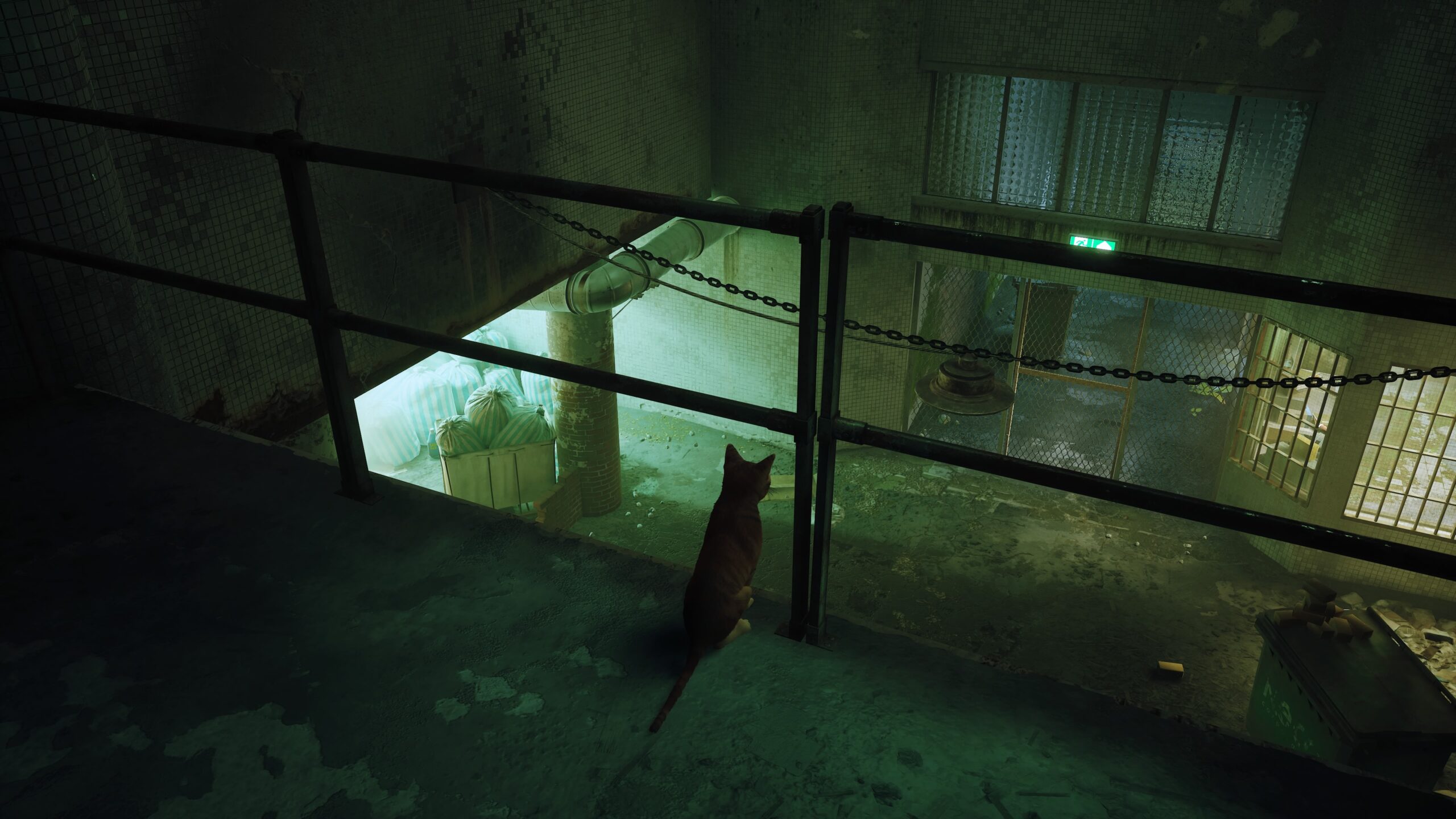
Hiding spots get used most often during stealth sequences in which you must avoid light cones from security bots. The stealth in Stray requires you to avoid the prowling security bots through the use of hiding spots and fast sprinting, and it’s usually not the irritating kind of stealth, thankfully enough. It’s always clear where the precise zones you will get caught in are and where safety is; just stay out of the security bot’s distinctly colored light cone, and you’ll be fine. With smooth controls, good visual distinction, and puzzle elements all in play, I found these sections to be pretty fun and tense, with one caveat. When you get caught and must flee and hide, the bots will sometimes stay stationed right over the box or wall you’re hiding behind for a tad too long. I tested how long they stayed there on high alert staring at the hiding spot a couple of times, and just left the game on standstill for ten minutes; half the time, the bots were in the exact same location, forcing the player to jump straight out into detection and swift death. It seems like the security bots were designed to patrol back to their original route after a little time in high alert search mode since that’s what they do most of the time, so I assume the eternal bot-hovering while hiding is a bug in the AI script. If it’s intentional that you’re stuck in a hiding spot with security flashing constantly right on you until you jump out and get caught, well, that’s just poor game design. Thankfully, most of the time, security leaves you after a while and goes back to its usual patrol route.
Chase Sequences
The last small annoyance I found in the action portions was in the chase sequences. These high-adrenaline sequences are heavily scripted and linear, much like the chases in platformers like Crash Bandicoot or even the mine cart sections of Donkey Kong Country. The camera is often fixed, and you must sprint through obstacles to avoid the swarm of enemies trying to harm the cute cat. These can be pretty fun in the way they break up gameplay flow, but they occasionally get frustrating due to how you’re railroaded on specific paths, lest you fail. In one chase sequence, a series of intersections opened their way for me to potentially shortcut through them. The game had taught and rewarded me for being explorative and curious up to then, so I naturally took the less-obvious path to the left. Well, bad idea, as it was a dead end leading to death. Okay, I’ll see if there’s a route on the right leading to a secret memory: nope, dead end. The game so consistently varies its terrain and goes out of its way to make everything look organic that it fails to make the correct route visually distinct and clear in the chases. It’s not a huge deal since we’re talking a grand total of two or three examples of railroading pathing during chase sequences, but it’s worth pointing out that some of the only deaths I had in the game were due to going the wrong way when nothing indicated it was the wrong way. But that’s it for my gripes with Stray. Besides occasionally lousy routing indications in chase sections, microsecond lag aiming the defluxor, and getting stuck in a surveillance hiding spot, there’s not a single thing I didn’t like in Stray. Miraculously enough, Stray’s story impressed me the most out of all its elements.
Subtle Storytelling
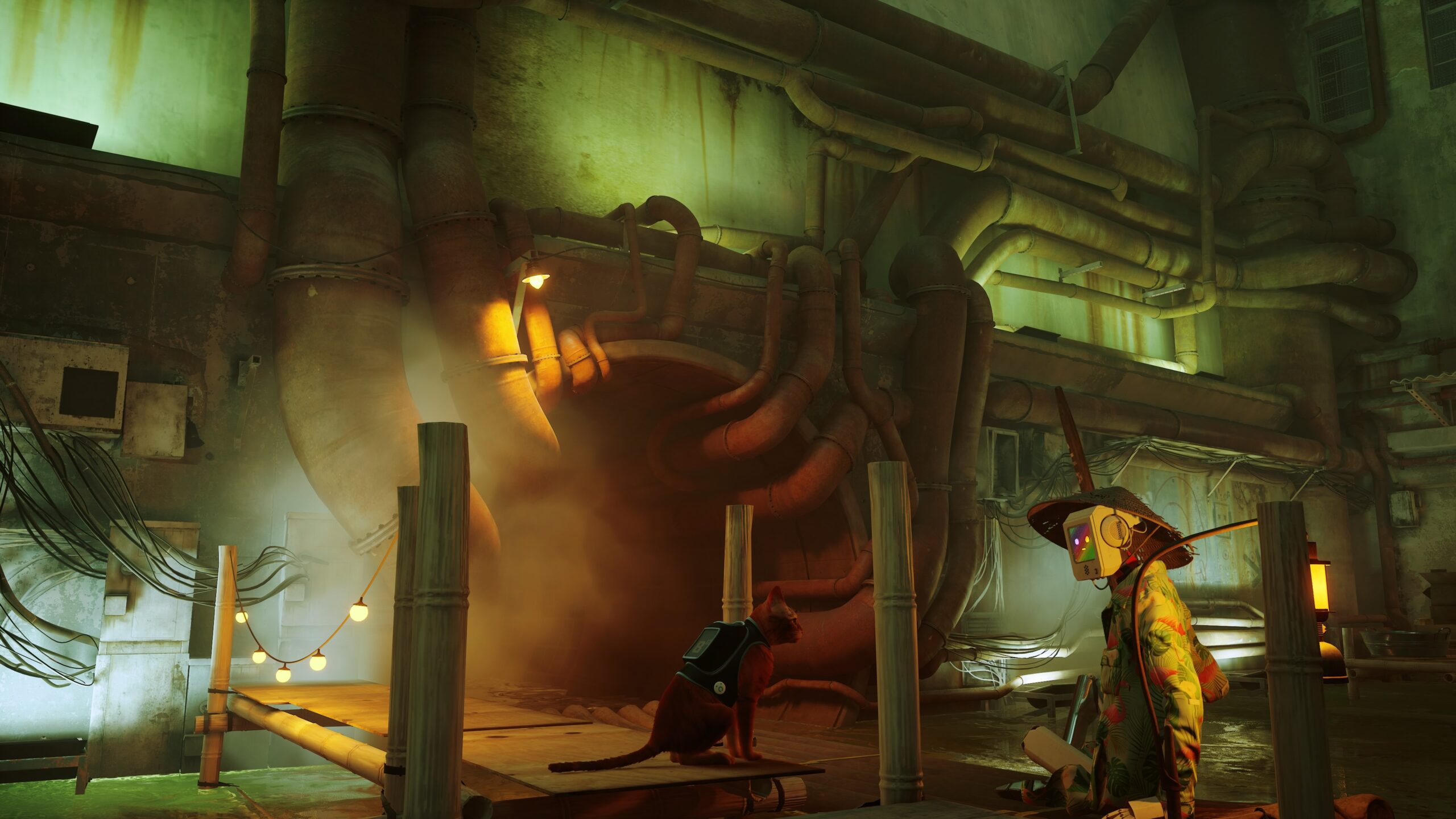
There are no story spoilers ahead, but be aware that certain elements of structure and theme are discussed. As seen in the trailers, Stray is about a cat that wanders into a long-abandoned cybercity and the subsequent journey out of the dystopia. But it’s deeper than just that when you peel back the layers and dive further into the game. The city has a history with long-forgotten secrets that only a stray cat can uncover, much of it simply by observing the environment and the stories it has to tell. Stray tells plenty of its tale through the environment, but a lot more of the story is uncovered through your AI bot companion as you put together and locate its lost memories. The dialogue with your companion bot is efficient and to the point, as are the tales and lore gathered from the robotic citizenry. One thing I like about Stray’s storytelling is how it avoids preaching a moral message and stays subtle. This ain’t no over-exaggerated anime JRPG with god-slaying angsty teens, not that I’m not into that. Stray is smart and clever with the information it gives the player and what it withholds from them, stirring the imagination and leaving some mysteries mysterious to the very end of the game. I never felt these loose ends were cheap carrots reserved for a sequel or anything of that sort. Rather, the subtlety and observer-oriented storytelling beckons further interaction with Stray’s world and increases immersion due to how lived-in and real it feels. There are no cheap story tricks to get the player invested. It’s all told through the eyes of a stray cat and its robot companion, who slowly regains his memories over the course of the adventure. This subtle storytelling might make some think the plot is boring or slow, but quite the contrary. The structure of the plot is brisk and wonderfully paced. You gain background information about the world as quickly as you want since exploring uncovers lore and opens up dialogue with citizenry who have stories to tell.
Plot Structure and Pacing
Like the environments, the story is superbly compact with just the right amount of density. The plot starts small and leisurely as you find your bearings in the city and introduce yourself to its charms and horrors, and then steadily ramps up in scale as you go on. This steady trajectory is felt in the environments themselves as you start out in the cramped and rugged slums and move on up from there, quite literally. By the end of the tale, you have a more complete grasp of the city’s situation and what you can do about it. Instead of merely being a lost tourist, you become something of a revolutionary who takes action. I simply adore the way this progression was done in Stray and feel the experience is complete without the need for a sequel despite there being some unsolved mysteries at the end. Stray feels like a complete story, just as it feels like a full video game in general, despite its size.
Characters and Conclusion
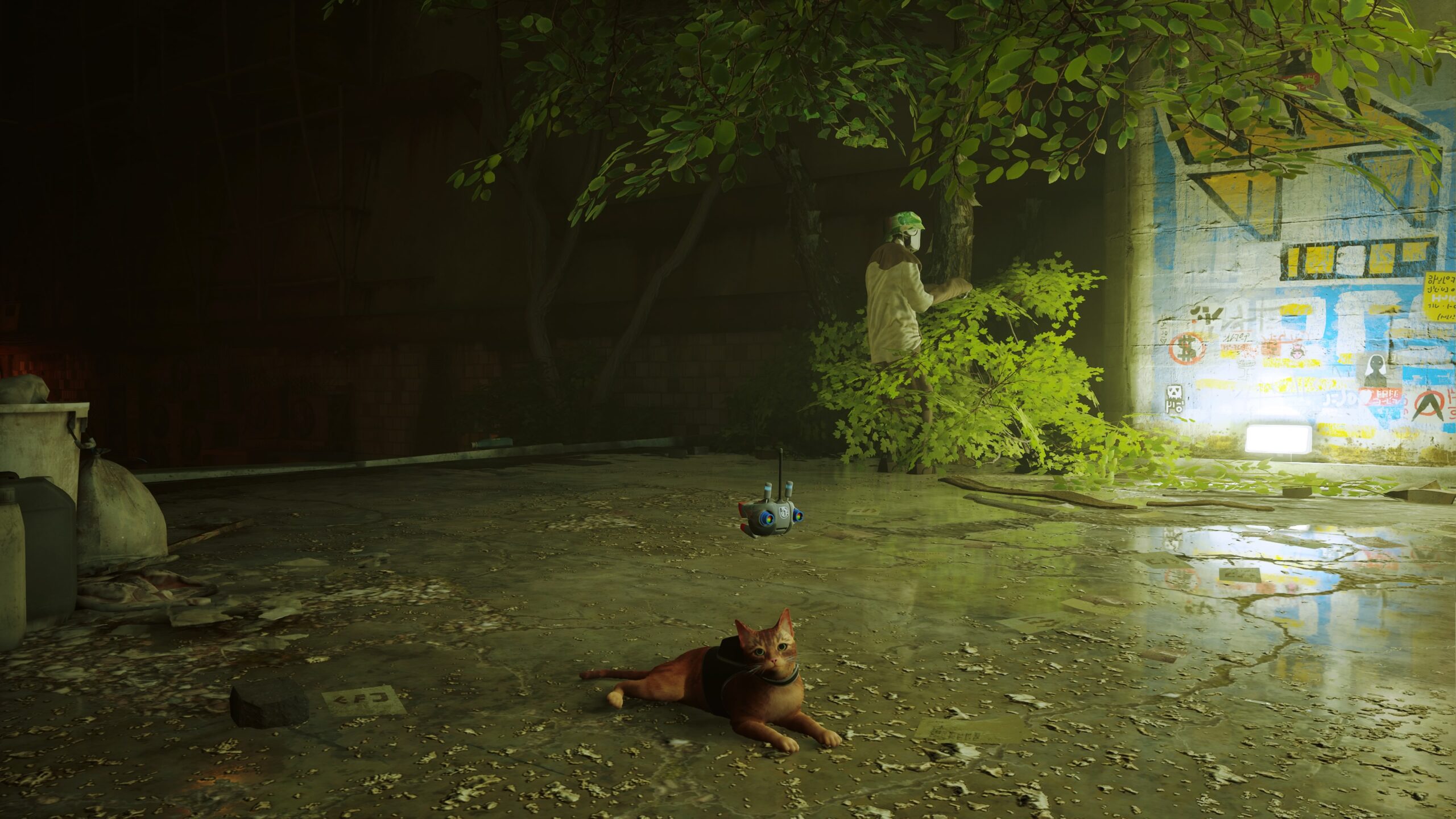
As far as characters go, let’s just say I didn’t quite expect to be attached to any character in Stray except the main cat. The theme of robots with developed sentience, emotion, and will has been done to death in video games as of late, and I wasn’t really in the mood for more, but Stray managed to surprise me by the end. Themes of faithfulness and companionship are fully expressed in very clever ways despite the desolate and dystopian cybercity our cat finds itself in. The dynamic between an animal and its companion isn’t dissimilar to how I felt playing Ico, Shadow of the Colossus, or The Last Guardian. In fact, the character dynamics and the way the story leaves some aspects ambiguous and mysterious, even down to the protagonist’s actions and motives, reminded me of Shadow of the Colossus in more ways than one. Stray even had me contemplating life by the end of it, a distinct phenomenon reserved for a select few notable games. And yet, like Fumito Ueda’s games such as The Last Guardian, this powerful effect is achieved through minimalist storytelling and a compelling and mysterious setting. The gameplay and visuals may have some Half-Life 2 DNA, but they also have that all-too-rarified Shadow of the Colossus feeling of a whole greater than its parts. Sure, the stealth and chase sections can be a little clunky and imperfect, but the overall experience of the journey and the heart and soul clearly put into it more than make up for its small shortcomings. Stray is a masterpiece in a similar way Shadow of the Colossus is; while it’s not perfect, it has lasting power and artistic prestige. The artistic direction of this cat’s journey through the walled cybercity is something not to be missed. This is a game that’s hard not to love, and thanks to the clear passion that went into every alleyway and story beat, it’s a must-play title despite its unassuming and demure appearance.
Stray (2022)
Gameplay - 9
Difficulty/Length - 9
Story - 9.6
Graphics - 9.6
Sound Design - 9.7
9.4
Great
Stray offers more than just a fun cat simulator. Sure, you can meow and nuzzle up against robots, but there's a masterpiece of storytelling and world design waiting to be unveiled. Gameplay is simple, yet addictive in exploring the dynamic and dense city, and the music and graphics are simply breathtaking. Exploring the hyper-detailed and rich dystopia of the walled cybercity is wildly compelling and fun. While there are a few irritations in the action-oriented sections, the overall experience of Stray far outweighs them. By the end of the journey, you'll feel like you just went through something irreplaceably special, and got to live out your cat fantasy to top it off.
Comments (2)

Yeah, the review answers the question why I find it unique. Can you point to specific parts in my review you don’t agree with instead of hasty generalizations? I also wrote about 3 aspects of gameplay and why they’re fun, so you’re going to need more arguments for your comment to be seen as anything but troll bait.








Can you give a reason why this game is unique? It has a cat and that’s it. Nothing about it otherwise is “unique”. The gameplay is nonexistent, it’s literally a walking sim. Jesus, reviewers like you really are a cancer.